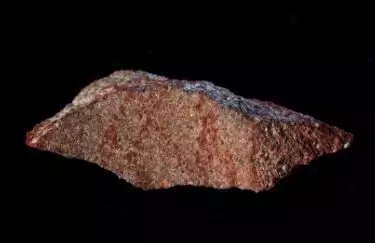The humble brown stone below, which we take a cursory glance at, probably assume that these red lines are naturally formed, however, this is the first known hand-painted painting of mankind to date.

Figure | The crossed crimson lines on the stone from 7330 years ago are likely part of a larger drawing. (Source: Craig Foster)
Scientists have shown through laboratory analysis that these rough intersecting dark red lines must have been painted with a softer colored stone called "ochre", and it is likely that they were cut, similar to a simple crayon.
The researchers drew the same lines on the rough stone with the same material, and after some experimentation, the results showed that these lines were not scribbled and scribbled, but took a lot of effort to create carefully.
(Source: Francesco d'Errico)
"[When drawing these lines] have to use a lot of pressure and control or you won't leave enough ochre," says Christopher Henshilwood of the University of Witwatersland in Johannesburg, South Africa.
"This represents the beginning of cultural modernity and complex behaviour," says Colin Renfrew of the University of Cambridge, "and we were very surprised to find that another species could create something like this." This represents the origin of mankind. ”
Henshilwood and his colleagues excavated the painting from layers of dirt in a South African cave some 73,000 years ago. This figure makes it twice as old as any of the Stone Age paintings we've created ourselves in previous excavations, even the recently discovered Neanderthals painted caves 64,000 years ago.
Modern humans, also known as Homo sapiens, evolved in East Africa about 200,000 years ago and then migrated to the northern and southern parts of the continent. Archaeologists have been studying the Blombos cave on the south coast for more than 20 years, unearthing a wealth of historical material from the people who lived there about 100,000 years ago.
Among them, the excavated artifacts include shell beads and spear tips made of stone and bone. Another controversial discovery was a set of painting tools — paint made from a mixture of ochre, charcoal and seal oil was found in a large sea snail shell, but no paintings have been found to date.
The latest painting, made on a stone measuring just 4×1.5 centimeters, was unearthed in 2011, but because it was covered in mud, it did not attract attention at the time, but was only labeled and preserved. It wasn't until a few years later, during the search for stone tools, that a team member discovered the markers and underwent a microscopic chemical analysis of the rock and the traces of ochre on it.
Ochre comes in many different forms and colors, some of which are as hard as children's crayons, making them ideal for painting. Judging by the width of those lines, the brush tip is about 2 mm, most likely deliberately sharpened.
The 9 lines on the stone stretch all the way to the edges, making one wonder if they were once part of a larger artistic painting, only to be broken down for some reason. For most lines, the team was able to distinguish the direction of the stroke because the tiny bumps on the stone surface allowed more ochre material to accumulate on the opposite side of the stroke direction. The painter must have repeated it several times when drawing a line to make it look wider. "There's no doubt that this was definitely intentional," Henshilwood said.
This stone "canvas" also tells us another story. The researchers found that the surface of the stone used for painting was smoother than the other side, and another ochre fragment as hard as rock was found inside its pit. This suggests that the stone may have originally been used as a grinding stone to polish the ochre into a powder, or perhaps used to paint it.
Henshilwood says we don't know if the intersecting lines were originally used for decoration or some other symbolism. "When you have a crayon like this, it's probably the first time ever that you can store information outside of your brain," he says, "and take this stone graffiti across the continent and you can leave a message anywhere." ”
Clive Finlayson of the Gibraltar Museum said, "It shows that these people think very similarly to what we have today, and they are able to express something by abstracting something." This suggests that they have cognitive abilities similar to ours. ”
Although this "graffiti" is very impressive, it is not the earliest work of art of mankind. There are many examples of earlier artistic designs, such as similar crossed line drawings obtained through carved stones, which is a simpler technique than drawing with crayons. The first known etched pattern to be found came from a clam shell in Indonesia dating back 500,000 years, so it must have been created by another type of hominid, Homo erectus.